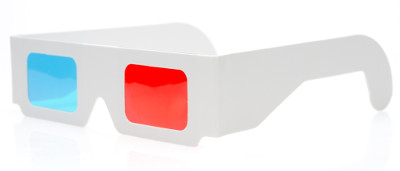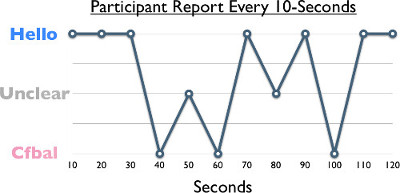Binocular Rivalry
Source: Laboratory of Jonathan Flombaum—Johns Hopkins University
Why do people have two forward-facing eyes? By presenting the brain with two ever so slightly different images it becomes possible to comprehend visual problems that are far more difficult to process through a single eye. Chief among these is the problem of 3-D perception, seeing the world in three dimensions, despite retinal inputs in only two dimensions.
What happens if each eye receives two completely different images? That does not happen in nature, to be sure, but it can be contrived in the laboratory in a set-up called binocular rivalry.
Binocular rivalry is a common laboratory paradigm for investigating the ways that the brain integrates information from two eyes, and in recent years, the mechanisms responsible for producing conscious experience.
1. Equipment
- To easily produce binocular rivalry, use a pair of red-cyan glasses (Figure 1).

Figure 1. A pair of red-cyan rivalry glasses. The glasses make it possible to present two overlaid images such that only one arrives to each eye. The red lens will filter out all but red light before it reaches a viewer’s eye, and the cyan lens will filter out all but blue light. This means that a b
The results can be graphed by plotting the raw data (Figure 3), which is what the participant reported seeing as a function of time.

Figure 3. Participants reports what he sees every 10-seconds. The majority of reports involve the coherent word ‘Hello.’ But critically, the object the participant is aware of changes frequently, and can chan
Binocular rivalry forms the basis for most 3D movies and games—although these days, they usually use other kinds of filters, not red and cyan. The logic is the same though: If two images are different in just the right ways, and presented to each eye separately, then the brain can be tricked into seeing 3D when the surface it is looking at is actually 2D, like a movie screen.
If you look at this picture (Figure 5) with the glasses, it should appear to be 3D.
Vai a...
Video da questa raccolta:

Now Playing
Binocular Rivalry
Cognitive Psychology
7.8K Visualizzazioni

Dichotic Listening
Cognitive Psychology
26.3K Visualizzazioni

Measuring Reaction Time and Donders' Method of Subtraction
Cognitive Psychology
44.0K Visualizzazioni

Visual Search for Features and Conjunctions
Cognitive Psychology
26.7K Visualizzazioni

Perspectives on Cognitive Psychology
Cognitive Psychology
6.9K Visualizzazioni

Multiple Object Tracking
Cognitive Psychology
7.6K Visualizzazioni

Approximate Number Sense Test
Cognitive Psychology
7.4K Visualizzazioni

Mental Rotation
Cognitive Psychology
13.0K Visualizzazioni

Prospect Theory
Cognitive Psychology
11.1K Visualizzazioni

Measuring Verbal Working Memory Span
Cognitive Psychology
12.4K Visualizzazioni

The Precision of Visual Working Memory with Delayed Estimation
Cognitive Psychology
5.1K Visualizzazioni

Verbal Priming
Cognitive Psychology
14.9K Visualizzazioni

Incidental Encoding
Cognitive Psychology
8.3K Visualizzazioni

Visual Statistical Learning
Cognitive Psychology
7.0K Visualizzazioni

Motor Learning in Mirror Drawing
Cognitive Psychology
55.2K Visualizzazioni
